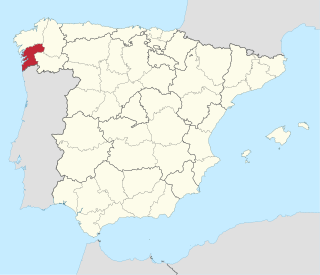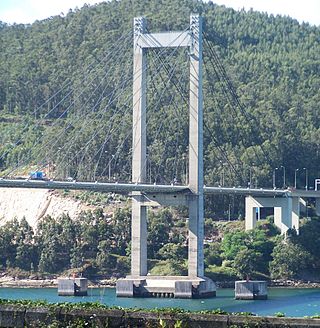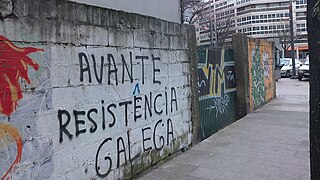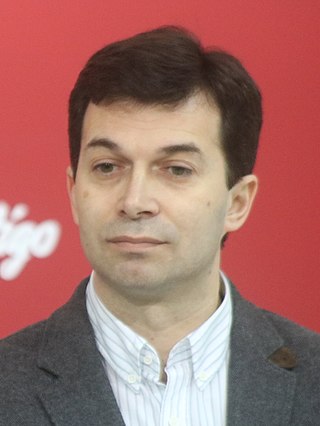
Galicia is an autonomous community of Spain and historic nationality under Spanish law. Located in the northwest Iberian Peninsula, it includes the provinces of A Coruña, Lugo, Ourense, and Pontevedra.

The province of A Coruña is the northwesternmost province of Spain, and one of the four provinces which constitute the autonomous community of Galicia. This province is surrounded by the Atlantic Ocean to the west and north, Pontevedra Province to the south and Lugo Province to the east.

Pontevedra is a province of Spain along the country's Atlantic coast in southwestern Europe. The province forms the southwestern part of the autonomous community of Galicia. It is bordered by the provinces of A Coruña, Lugo, and Ourense, the country of Portugal and the Atlantic Ocean. The official languages of the Pontevedra province are Spanish and Galician. There is a public institution called the Provincial Deputation of Pontevedra, whose head office is in Pontevedra city, that provides direct services to citizens such as technical, financial and technological support to the councils of the 62 municipalities of the province of Pontevedra.
The Xunta de Galicia is the collective decision-making body of the government of the autonomous community of Galicia, composed of the President, the Vice-President(s) and the specialized ministers (Conselleiros).

The University of Vigo is a public university located in the city of Vigo in the Province of Pontevedra, Galicia, Spain. There are three campuses:

Galicia's two major economic poles are A Coruña and Vigo, with A Coruña in the lead, producing an estimated 33.2% of VAT receipts against 24.3% from Vigo. A third economic center is Santiago de Compostela, capital of Galicia. Other important cities are Ferrol and Pontevedra. In recent years the distance has grown between the interior provinces, Lugo and Ourense, which are more rural and less developed, and the coastal provinces, Pontevedra and A Coruña, particularly the areas situated along the axis of the A-9 Highway.

Resistência Galega, sometimes referred to as REGA, is the term used by a series of left-wing and Galician separatist organisations and individuals to claim attacks in Galicia. The term was first used in 2005 when a manifesto named Manifesto da Resistência Galega appeared on the Internet. Since then, Resistência Galega has carried out dozens of attacks against political party offices and banks across Galicia.
The Tour of Galicia is an annual cycling race held in Galicia, Spain. It was first held in 1933 and was held a further five times between 1934 and 1984. The tour did not take place from the outbreak of the Spanish civil war in 1936, until the end of the second world war in 1945. In 1986, it became a regular annual race. The final professional edition of the race was held in 2000. In 2002, after a year's hiatus, the race returned to the calendar as an amateur race.

The 1985 Galician regional election was held on Sunday, 24 November 1985, to elect the 2nd Parliament of the autonomous community of Galicia. All 71 seats in the Parliament were up for election.

Galician Coalition is a political party in Galicia, Spain with a Galician nationalist and centrist ideology. Since 2012 CG is part of the coalition Compromiso por Galicia.

Ourense is one of the four constituencies represented in the Parliament of Galicia, the regional legislature of the autonomous community of Galicia. The constituency currently elects 14 deputies. Its boundaries correspond to those of the Spanish province of Ourense. The electoral system uses the D'Hondt method and a closed-list proportional representation, with a minimum threshold of five percent.
A referendum on the approval of the Galician Statute of Autonomy was held in Galicia on Sunday, 21 December 1980. Voters were asked whether they ratified a proposed Statute of Autonomy of Galicia bill organizing the provinces of La Coruña, Lugo, Orense and Pontevedra into an autonomous community of Spain. The final draft of the bill had been approved following an inter-party agreement on 26 September 1980, but it required ratification through a binding referendum and its subsequent approval by the Spanish Cortes Generales, as established under Article 151 of the Spanish Constitution of 1978.
This is the results breakdown of the local elections held in Galicia on 3 April 1979. The following tables show detailed results in the autonomous community's most populous municipalities, sorted alphabetically.
This is the results breakdown of the local elections held in Galicia on 8 May 1983. The following tables show detailed results in the autonomous community's most populous municipalities, sorted alphabetically.

Gonzalo Caballero Míguez is a Spanish economist and politician. He is the secretary-general of the Socialists' Party of Galicia (PSdeG-PSOE) since 2017.
Gloria Fernández Fernández was a Spanish painter born in Monforte de Lemos in 1913. She died in Madrid in 1996. She is included in the Bibliography of Galician Painters. Gloria has exhibited in the Spanish cities of Monforte de Lemos, A Coruña, Santiago de Compostela, Vigo and Madrid. Her work includes still lifes, flowers, portraits, and human figures. She was featured in an extensive exhibit of her works at the Provincial Museum of Lugo. The exhibition and her work are featured in a catalog of the exhibition that includes information about her evolution as an artist. Gloria was one of the pillars of the Monforte de Lemos intellectual community in the 1960s and, according to M. Hermida Balado from her book Lemos: pequeña historia de un lugar con mucha historia, was one of the three notable painters of the province at that time.
The military regions of the Spanish Armed Forces were a administrative subdivision that existed in Spain from the 18th century to the end of the 20th century. They constituted a territorial subdivision in terms of the allocation of human and material resources for defence purposes, and responded to a territorial defence model.

The III Military Region also known as the Captaincy General of Valencia, was a historical subdivision of Spanish territory from the military point of view - a military district, from 1939 - 1984. Its jurisdiction extended through the provinces of the current Valencian Community, and the Murcia Region. The region's headquarters was located in Valencia.

The Provincial Savings Bank of Pontevedra was a Spanish financial institution based in the city of Pontevedra (Spain) dependent on the Provincial Council of Pontevedra, existing between 1930 and 2000.
In the run up to the 2023 Spanish local elections, various organisations carry out opinion polling to gauge voting intention in local entities in Spain. Results of such polls for municipalities in Galicia are displayed in this article. The date range for these opinion polls is from the previous local elections, held on 26 May 2019, to the day the next elections will be held, on 28 May 2023.












